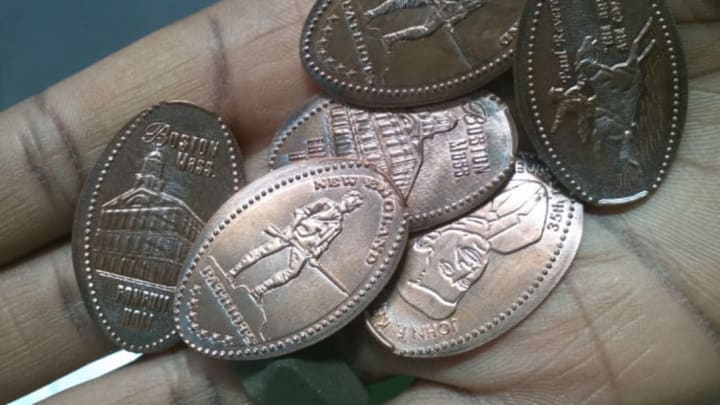Visitors to the 1893 World’s Fair in Chicago—known at the time as the Columbian Exposition because it was the 400th anniversary of Columbus’s voyage—had an opportunity to see a lot of innovative new ideas for the first time. Wrigley’s debuted their chewing gum; guests got to ride a Ferris Wheel; if you were hungry, you could eat an early version of Cracker Jack. Constipated? Shredded Wheat premiered there, too.
But the one attraction that the throng of visitors couldn’t seem to get enough of was the penny press machine. For a nickel, a press operator would accept a coin from a guest, stick it between two industrial-strength rollers exerting several tons of pressure, and apply a hand crank. Out would come the coin—usually a penny—that had been squished and deformed so it now looked like an abstract flourish in a painting. Oval-shaped, it bore a stamp that had been embossed by a mold on one of the rollers: “Columbian Exposition 1893.”
Bev Sykes via Flickr // CC BY 2.0
Informally, they’re known as penny pressers, penny crushers, or squishers. To collectors, they’re coin elongation machines that produce elongated coins, flattened currency that uses your loose change to emboss a design depending on where the machine is found. In Roswell, New Mexico, machines will craft UFOs onto pennies; at the Audubon Aquarium in New Orleans, penguins and other animals appear; at Disneyland, you can get Mickey Mouse and countless other characters.
Elongated coins are part of what numismatists called exonumia, or oddball coins that don’t fit any standard definition of money. (Add wooden nickels to the list.) Although steam-powered press machines had been around as early as 1833 (and there are elongated coins believed to be from around 1818), it wasn’t until the 1893 Chicago exhibition where a modified jeweler's mill was on display—courtesy of an unknown but fairly clever jeweler—that they experienced a surge in popularity. Part of it was the theatrical experience—stick a seemingly indestructible coin in and watch it change shape—and part of it was having an inexpensive way of memorializing a visit to a popular attraction.
The coin presses began popping up around the country before experiencing a lull in 1916, and it wasn’t until 1932 that tourist spots started to see an uptick in their use. Another resurgence happened in 1976, the bicentennial, when collectors were eager for commemorative material from the celebration.
The rising interest continued in the 1980s, thanks in some measure to the Disney parks incorporating them into many of their high foot-traffic locations. Disney even has a full-time employee, Rob Johnson, who's in charge of maintaining their machines, often turning to companies like EuroLink for the engraving dies. Engravers like Jim Dundon often slip in their initials as a kind of artist's signature. Collectors who are serious about elongates prefer to find or use pennies made pre-1982, before the U.S. Mint switched to a predominantly zinc composition that made elongated pennies look prematurely dark and worn.
Liz Lawley via Flickr // CC BY-SA 2.0
It’s not known exactly how many of the elongation machines are installed around the U.S., but there are enough in use that some collectors use their location as markers for cross-country travel, sometimes even traveling to a specific destination to fill a hole in their collection. (Because the number of stamped coins is so vast, collectors sometimes stick to a specific genre, like space travel or politics.)
They take these self-styled “squishin’ missions” pretty seriously: One elongate enthusiast profiled in Colorado Life magazine admitted to nearly breaking down in tears when she saw a child jam the machine she had driven hundreds of miles to access. Another notable exonumia fan, Pete Morelewicz, ran a museum in Washington, D.C. for several years, complete with a hard-luck tale: once, a machine devoured the tip of his finger.
Once a penny has been spit out to a wafer-thin shape, can it be reused as currency? Probably not, but the U.S. Mint isn’t going to make a big deal of it. But if you use the squished coin to pass off a nickel for a quarter, that’s a very different matter. Providing you aren’t mutilating currency for counterfeiting purposes, they don’t have a problem with the machines. Just watch your fingers.
